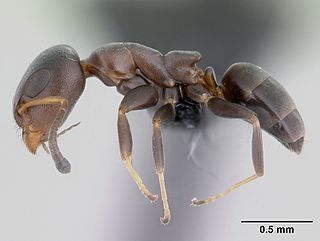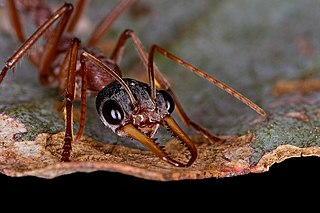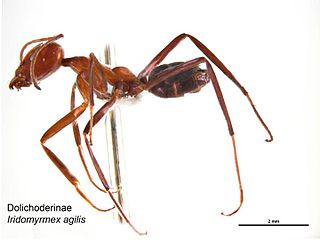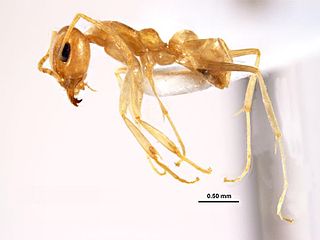
Dolichoderinae is a subfamily of ants, which includes species such as the Argentine ant, the erratic ant, the odorous house ant, and the cone ant. The subfamily presents a great diversity of species throughout the world, distributed in different biogeographic realms, from the Palearctic, Nearctic, Afrotropical region and Malaysia, to the Middle East, Australian, and Neotropical regions.

Turneria is a genus of ants that belongs to the subfamily Dolichoderinae. Known from Australia, they form small colonies of fewer than 500 workers, and nest in trees and twigs.

Anonychomyrma is a genus of ants in the subfamily Dolichoderinae.

Iridomyrmex is a genus of ants called rainbow ants first described by Austrian entomologist Gustav Mayr in 1862. He placed the genus in the subfamily Dolichoderinae of the family Formicidae. It has 79 described species and five fossil species. Most of these ants are native to Australia; others are found in Asia and Oceania, and they have been introduced to Brazil, New Zealand, and the United Arab Emirates. Fossil species are known from China, France, and the United States.

Leptanilla is a genus of ant in the subfamily Leptanillinae. Like other genera in this subfamily, the queen is fed by the hemolymph of their own larvae, which have specialized processes for this purpose.

Myrmecia nigriceps, also known as the black-headed bull ant, is a species of ant endemic to Australia. A member of the genus Myrmecia in the subfamily Myrmeciinae, it was first described by Austrian entomologist Gustav Mayr in 1862. These ants are large, varying from 19 to 23 millimetres in length. However, colonies contain workers that are much smaller, usually half the size of normal workers. The queens are the largest while the males are the smallest, which can be easily identified due to their small mandibles.

Rhytidoponera is a large genus of ants in the subfamily Ectatomminae. The genus is known from Australia and Melanesia, with New Caledonia as the most eastern limit.

Doleromyrma darwiniana is a species of ant in the genus Doleromyrma. Described by Forel in 1907, the species is endemic to Australia and introduced to New Zealand, and it nests in soil or under stones and logs. The organism grows to a length between 2.0 and 3.0 millimeters. This species of ant maintains small colony sizes and it "prefers protein food." The species is also known by some sources as the "brown house ant" and "Darwin's ant". The species is considered a "minor urban pest" in New South Wales.

Melophorus is a genus of ants in the subfamily Formicinae. The genus is endemic to Australia, where its species are common in arid and semiarid areas.

Stigmacros is an Australian genus of small ants in the subfamily Formicinae. The genus is endemic to Australia. They are generalist predators that forage in the leaf litter, on the ground or in trees.

Prolasius is a genus of ants in the subfamily Formicinae. Of the genus' 19 species, 18 are known from Australia and one from New Zealand. They nest in soil under rocks or logs, sometimes in trees.

Notoncus is an Australian genus of ants in the subfamily Formicinae. The genus is known from Australia, where the ants nest in the soil or on the ground under stones and logs in forested areas. The ants are also common in gardens and parks.
Myrmecia nigra is an Australian ant which belongs to the genus Myrmecia. This species is native to Australia and is commonly distributed in Western Australia, notably in Perth.

Myrmecia michaelseni is an Australian ant which belongs to the genus Myrmecia. This species is native to Australia. They are mostly distributed and studied in Western Australia.

Iridomyrmex agilis is an ant of the genus Iridomyrmex. They are distributed throughout most of Australia. They are usually found in the drier regions of Australia. The species was described by Auguste-Henri Forel in 1907.

Iridomyrmex exsanguis is a species of ant in the genus Iridomyrmex. Described by Auguste-Henri Forel in 1907, the species is distributed nationwide in Australia.

Iridomyrmex hartmeyeri is a species of ant in the genus Iridomyrmex. Described by Auguste-Henri Forel in 1907, the ant is a nocturnal forager, and it distributed in most of Australia.
Iridomyrmex innocens is a species of ant in the genus Iridomyrmex. Described by Auguste-Henri Forel in 1907, the species is endemic to Australia, mainly confined in Western Australia, but the species is more common in areas with higher rainfalls within the Darling Ranges.

Iridomyrmex rufoniger is a species of ant in the genus Iridomyrmex. It was described by Lowne in 1865. The species is endemic to Australia and introduced to several other countries.

















